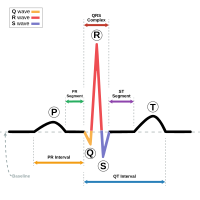
Photo from wikipedia
Background: Until today, catheter interventional mapping and ablation of atrial fibrillation (AF) has been limited to the right and left atrial endocardium. We report feasibility, electrophysiological findings, and clinical outcome… Click to show full abstract
Background: Until today, catheter interventional mapping and ablation of atrial fibrillation (AF) has been limited to the right and left atrial endocardium. We report feasibility, electrophysiological findings, and clinical outcome using a combined endo-/epicardial catheter approach for mapping and ablation of AF. Methods and Results: Fifty-nine patients with permanence of pulmonary vein isolation and further symptomatic recurrences of paroxysmal AF, persistent AF, or atrial tachycardia underwent reablation using biatrial endo-/epicardial mapping and ablation. Identification of arrhythmia substrates and selection of ablation strategy were based on sinus rhythm voltage mapping. Using continuous monitoring and a 3-month blanking period, freedom from AF/atrial tachycardia ≥2 minutes was defined as primary end point. In all patients, endo-/epicardial mapping and ablation was feasible using standard technologies of catheter access, 3-dimensional mapping, and radiofrequency ablation. Epicardial mapping and ablation did not add procedural risks. Exclusively epicardial low voltage substrates were found in 14% of the patients. For the first time, novel epicardial conduction abnormalities located in the epicardial fiber network were described in human AF patients (19% of the cohort). Epicardial ablation was needed in 80% of the patients. Over 23±10 months of follow-up freedom from arrhythmia recurrences measured 73%. Conclusions: Catheter-based endo-/epicardial mapping and ablation of AF was feasible and safe. Epicardial mapping provided new insights into AF mechanisms. Epicardial ablation increased transmurality of ablation lesions. Clinical outcome in this cohort of complex AF patients was favorable, indicating potential further development of current AF treatment.
Journal Title: Circulation: Arrhythmia and Electrophysiology
Year Published: 2018
Link to full text (if available)
Share on Social Media: Sign Up to like & get
recommendations!